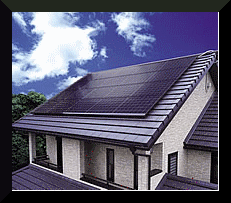 Two intriguing stories about unusual ways of contributing to the fight against climate change caught my attention yesterday. The first was an article in Christian Science Monitor about physicist Hashem Akbari’s formula “to determine how much heat-trapping carbon dioxide would be offset by reflecting the solar radiation back into space”. He suggested “replacing the dark shingles on a 1,000-square-foot roof – the average size of an American home – with white material”. He claims that would offset 10 metric tons of greenhouse gases.
Two intriguing stories about unusual ways of contributing to the fight against climate change caught my attention yesterday. The first was an article in Christian Science Monitor about physicist Hashem Akbari’s formula “to determine how much heat-trapping carbon dioxide would be offset by reflecting the solar radiation back into space”. He suggested “replacing the dark shingles on a 1,000-square-foot roof – the average size of an American home – with white material”. He claims that would offset 10 metric tons of greenhouse gases.
On a global scale “roofs account for 25% of the surface of most cities, and pavement accounts for about 35%. If all were switched to reflective material in 100 major urban areas, it would offset 44 metric gigatons of greenhouse gases”, which is “more than all the countries on Earth emit in a single year.” I love CSM’s passing observation on the idea: is this greenwash with whitewash? Well, I guess we’ll have to wash this space…
Elsewhere, in cutting-edge Holland, a nightclub in Rotterdam reopened its doors with the promise of being the ‘greenest disco in the world’. How so? The owners of Watt, the name of the venue, claim the establishment is the first to follow all the criteria set by the Sustainable Dance Club (SDC), a concept created in Holland two years ago to stimulate nightclubs to adopt alternative sources of energy.
But the best thing about Watt is that clubbers themselves will provide the main energy matrix since it will be captured through sensors installed under the dancefloor, and will then be converted into ambient lighting. They claim each person can generate betwen 5 to 10 watts of electricity, depending on their weight. Those up for an intense, funky workout can generate up to 20 watts, according to Watt’s owner Aryen Tieleman. Oh yes, and water supply will be provided by the skies, through boxes installed on the roof. The water then travels down to the services via transparent tubes before undergoing a purification process in underground tanks. That will save the venue 1,000m³ of water per year. Finally, the bar will be serving on organic food and drinks only and staff uniform, of course, is made of recycled materials.






Talk about a hip dance club!
This sounds very interesting and I will be taking a look at the article you recommended. I would love to visit the club to see what they have done. I guess every little bit of eco friendly activities will help.
Hey, here’s an idea: change your website to a dark background to reduce monitor energy use.
Now various governments are offering tax breaks for roof mounted solar installations, white roofs may not go over well, but concrete highways, finished with white or light sand may soon replace carcinogenic ashfaults. Once the word gets around, ashfault causes breast and other cancers, we may see an anti-ashfault movement, but the truth has yet to be unsuppressed!